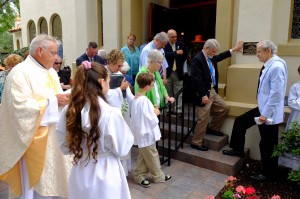
Today we dedicated a plaque designating Holy Cross as listed on the National Register of Historic Places – NPS Fr. James Booker blesses the plaque as Dr. James Louttit, MD and Rev. Alfred Cole unveil the plaque.
Over the past seven months, Holy Cross Episcopal Church in Sanford has embarked on a major renovation of the exterior of its historic structure. The Church has a fascinating history that is tied closely to the City of Sanford and to Central Florida in general.
On Sunday April 12, 2015, the Church dedicated a plaque commemorating the building’s listing on the National Register of Historic Places.
The congregation is extremely proud of the impact the Church has made on Sanford and Central Florida over the last 142 years. Holy Cross Episcopal Church in Sanford was established in 1873 at the direction of Henry Shelton Sanford from Connecticut. General Sanford arrived in the area in 1870. He saw great promise for this area as a port to supply south Florida.
Lake Monroe was the southern terminus for steamboat traffic on the St. Johns River, just 200 miles from Jacksonville. Henry Sanford also saw fertile land for growing citrus fruits and vegetables. He purchased 12,547 acres and laid out a town. He designated lots for an Episcopal church. This was the first Episcopal mission in Central Florida.
Sanford’s wife, Gertrude, took great interest in the church and wrote letters to her wealthy friends in the North to solicit donations for the church. Money was raised and the church was built using plans by renowned architect, Richard Upjohn, who designed Trinity Church in New York City. The style was of Carpenter Gothic.
The first rector was the Rev. F.R. Holeman. The Church was consecrated on “Low Sunday” April 20, 1873 (the second Sunday in Easter). In the summer of 1880 a devastating hurricane destroyed the church and groves. Homes and groves throughout the county were torn apart. Rebuilding was immediately begun, and a modified Upjohn church was completed in 1882 using materials, where possible, from the ruins of the first church.
On November 27, 1923 another catastrophe occurred. A fire destroyed the entire complex of buildings, all church records, the priest’s collection of important books and all the furnishings. The city fire hydrants could not supply enough pressure to aid the fire department in putting out the fire as it raced through all the buildings and a nearby house.
Again, the congregation began making plans to rebuild. A local architect, Elton Moughton, designed the new buildings that sit on the site of the original church today. Raising money for building was not a problem as this was the 1920’s land boom years so a grander, more elaborate Holy Cross Church was planned to include a fully equipped parish house, kitchen, dining hall, library and an apartment.
The architecture of the buildings is known as “pre-depression Spanish” and they are considered to be an excellent example of the period. From 1930 to 1933 the Rev. Henry Louttit and then the Rev. Martin Bram, 1933 to 1941, guided the parish through the difficult years of the depression. Both priests later became bishops of the Central Florida Diocese.
Holy Cross has the distinction of being referred to as the “Mother Church of Central Florida”, because many missions were established during those early years. Today, Holy Cross is an active place for ministry where the congregation cherishes its rich history and works in the present to nurture members, and the Sanford Community as a whole.
As Senior Warden David Johnson points out, “The warmth, beauty and spirituality of Holy Cross are evident to all who attend. We eagerly reach out to our neighbors to join us on Sunday at 9:00 AM at this friendly, caring church.”
